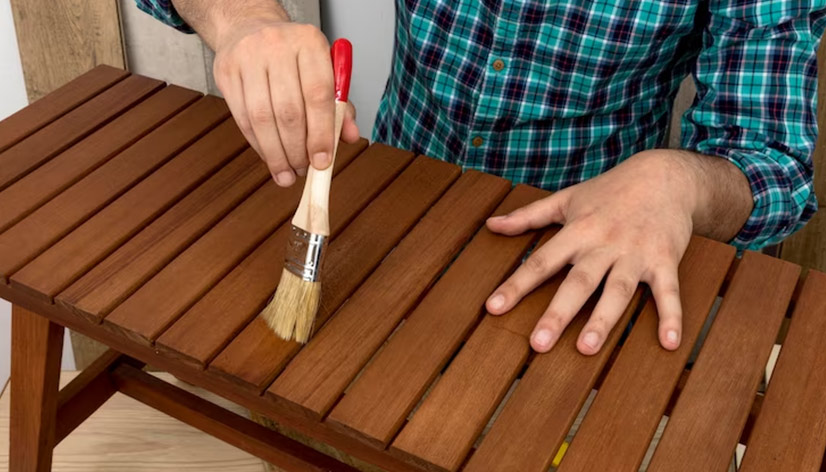
Protect Your Wood
Revamp Your Wood with Our Wood Protection Coating Services
Welcome to our House Wood Protection Coating Services, where your home's transformation is our mission. Painting not only enhances the aesthetic appeal of a room but also protects surfaces from wear and tear, sunlight, moisture, and other environmental factors.
Re-painting can be part of routine maintenance or a way to update the look of a space without major renovations.
Whether you're looking to refresh your current color scheme or completely reinvent your space, here's why you should choose us for your house Wood Protection Coating project:
-
Surface Preparation
Proper surface preparation is essential for achieving a smooth and long-lasting paint finish. This may involve cleaning surfaces, repairing cracks or holes, sanding rough areas, and applying primer as needed. -
Color Selection
Choose paint colors that align with the desired ambiance and style of the space. Many painting service providers offer color consultations to help you select the right shades for your walls and other surfaces. -
Type of Paint
Different areas may require different types of paint, such as interior, exterior, matte, eggshell, satin, or gloss finishes. The type of paint chosen should be suitable for the specific location and its exposure to elements like sunlight and moisture. -
Application Techniques
Skilled painters use techniques like brushing, rolling, and sometimes spraying to apply paint evenly and smoothly. Attention is paid to avoiding drips, streaks, and brush marks. -
Protection and Cleanup
Furniture, floors, and other items in the area being painted are often covered or moved to prevent paint splatters. After the painting is complete, the area is cleaned up to leave it looking tidy. -
Quality of Materials
Using high-quality paints, primers, and tools can significantly impact the overall finish and longevity of the paint job. -
Specialty Finishes
Some painting services offer specialty finishes, such as faux finishes, texture coatings, and stenciling, to create unique and visually appealing effects. -
Exterior Re-painting
Re-painting the exterior of a building is important for curb appeal and protection against weathering. Exterior re-painting may involve power washing, repairing exterior surfaces, and applying weather-resistant paint. -
Commercial and Residential Re-painting
Re-painting services are offered for both residential and commercial spaces. Commercial projects may involve larger areas, specialized coatings, and working around business hours.
Frequently Asked Questions - FAQs
Certainly, here are some frequently asked questions (FAQs) related to painting
-
What factors should I consider when choosing
paint colors for my space?
Consider the room's purpose, lighting, and existing decor.
Test samples on the wall to see how they look in different lighting conditions.
Think about the mood you want to create and how the colors will interact.
-
How do I prepare a
room for painting?
Remove furniture, fixtures, and wall hangings.
Clean the walls to remove dirt, dust, and grease.
Patch any holes or cracks, and sand the surface for a smooth finish.
Protect floors and remaining furniture with drop cloths.
-
Do I need to use primer before painting?
Primer is recommended, especially for new or porous surfaces.
It helps paint adhere better, covers stains, and provides a consistent base for color. -
How many coats of
paint should I apply?
Typically, two coats are recommended for an even and consistent finish.
Dark colors may require additional coats to achieve full coverage.
-
What is the best
paint finish for different rooms?
Flat or matte finish for ceilings and low-traffic areas.
Eggshell or satin finish for walls in living rooms, bedrooms, and hallways.
Semi-gloss or gloss finish for high-traffic areas, trim, and bathrooms.
-
Can I paint over
wallpaper?
Yes, you can paint over wallpaper, but proper preparation is crucial.
Remove any loose wallpaper, repair damaged areas, and apply primer before painting.
-
How long does
paint take to dry?
Drying times vary depending on factors like humidity, temperature, and type of paint.
Latex paint can be touch-dry in a few hours, while oil-based paint may take longer.
-
Can I paint in
cold or humid conditions?
Most paints have recommended temperature and humidity ranges for optimal application.
Painting outside of these ranges can affect drying time and overall finish quality.
-
How do I clean
paint brushes and rollers?
For latex paint, clean brushes and rollers with soap and water.
For oil-based paint, use paint thinner or mineral spirits followed by soap and water.
-
Should I hire a
professional painter or DIY?
It depends on your skills, time, and the complexity of the project.
Professionals bring expertise, tools, and experience for a polished result.
-
How can I
prevent drips and streaks while painting?
Use quality brushes and rollers.
Remove excess paint from brushes before applying.
Apply paint evenly and avoid overloading the brush or roller.
-
How can I
maintain and touch up painted surfaces?
Keep leftover paint for touch-ups.
Store it in a cool, dry place and make sure the lid is tightly sealed.
Gently sand the area before touching up to ensure a smooth finish.
